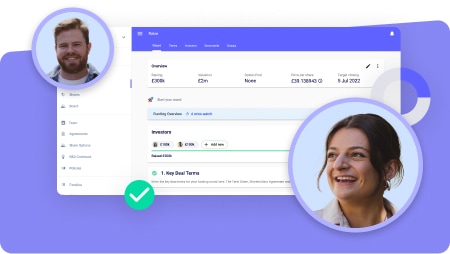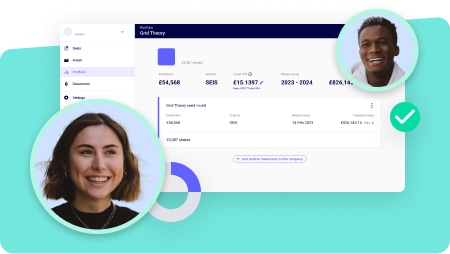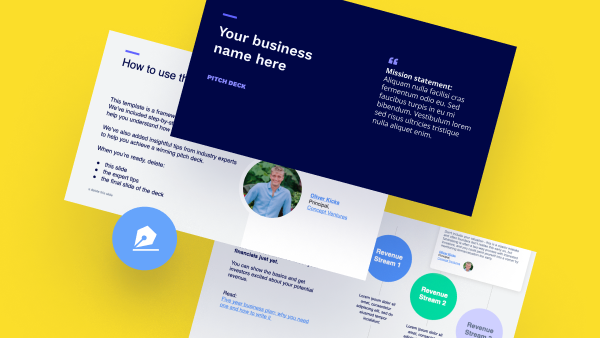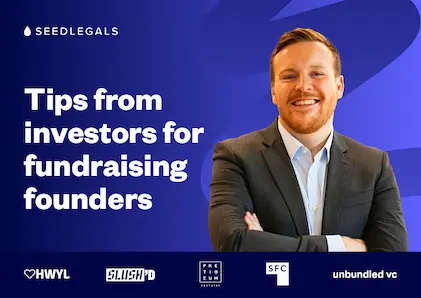Read transcript
Anthony Rose: So hello, everyone. Today we’re talking about down rounds. Now, when you start a company, your goal, of course, is to grow the company. So you raise money, and ideally, every 12 to 18 months you can have a new round. You’re going to raise 3 to 5 times the amount of the last round at 3 to 5 times the valuation of the last round, and I think the magic formula, if you can achieve it is your goal is perhaps over 3 funding rounds, each time raising 3 to 5 times the last round at 3 to 5 times the valuation, such that after the 3rd round you either are profitable and don’t need to raise again, or you’re ready to exit, and you find a buyer and have a nice exit, and everyone makes for the investors a good return on their investment, and for the founders. You get something from all your hard work, and being underpaid for many years.
But of course things always don’t go to plan. Sometimes they go slightly less to plan, sometimes they go way off, and particularly these days where interest rates are higher. That means investors need more of a return on their investment to balance otherwise just keeping the money in the bank. So valuations have been down for the last few years. Fundraising is harder, there’s less money potentially available, and that means, if you are unable to raise at the valuation you want what to do next. So today we’re talking about the down, round and down rounds, I think broadly, you can put them in 3 categories. There’s not an up round.
So we raised a few years back at, you know, 3 million valuation we’re now raising. We can’t raise it much more than 3. Maybe it’s like 2 and a half. Not a huge issue, but not an up round. That’s class one class 2 is quite a discount. Our last round was way too effervescent. We raised it at 10 million. No one’s interested in that price. We need to raise it 5 million to tempt people. We were just crazy, enthusiastic. So I’ll put that, as the you know, substantial discount. And the 3rd category is, you know, the sort of total wipeout which was, we raised it a 10 million, and actually we can now raise it at 300,000 pound.
Valuation like this is often called lost man standing. So with me today to discuss all of this is Rufus Rufus over to you, to introduce yourself.
Rufus Pearl: Hi, there! Yeah, thanks for that, Anthony. And Hi, everybody! I’ll just give a very brief overview of what we do, and you’ll very quickly see why. We are well placed to see what’s happening in the market. So effectively, you know, as an in as an Asian investor. It’s a portfolio approach. You invest in multiple companies, and you only need the top few to do well in order to show a decent return. And that’s because of the incredible tax breaks not least on the tax free upside, but also on the loss relief on the downside. But a lot of companies end up in this locked middle where they don’t fail. But they just underperform. And there’s nothing you can do about that situation. And so we’ve created a mechanism by which angel investors can choose to exit those companies at today’s fair value. So in the examples that Anthony was giving if you invested at, you know, 3 million. And it’s now 50% down. Or if it’s 90% down, or even 99% down, if if it’s not worthless and trending to 0. You can’t do anything about it. And so we have created a way for people to effectively crystallise and exit and take their losses. And it’s a massive, massive problem.
But as a result we are clearly seeing a lot of investors come to us and say, I invested in this company. The hope and expectation didn’t materialise. It’s come down in value, either. I think it’s worth, you know, X. And I want to get rid of it, but there’s no market, or they’ve just done a down round and I don’t know what to do. And we’re there, and we see that all day long sometimes founders come to us, because obviously it’s a difficult situation. If you haven’t performed then you may have some investors on a cap table that are causing a storm, and shouting and saying, You know, get me out of here. I I don’t wanna be on this cap table anymore. And it’s very difficult to find, because there aren’t any ways to do that.
So that’s why we built plan d and you know, as Anthony said, we’re seeing a lot of these deeply discounted rights issues. And you know, it’s even down to a sort of, you know, even a 10,000 pound pre money valuation is completely mind blowing. A lot of founders don’t even know that this is a mechanism by which they can reset. And yeah, so that’s that’s that’s a bit of a bit of background.Anthony Rose: All right. So over this call, we’re going to go through the things. And if you’re a founder and you’re encountering potential for a down round hopefully. All the things that would come to mind for you from is this legal? What can my investors do? Can my investors fire me? How do I keep them happy? Can they be unhappy? What do I do next?
So the 1st thing is to say, there’s no shame or embarrassment in a down round. The term down sounds like a downer, but I think of it as a failure to be an upper in a sense. So you know, you made a bet when you started the company that things would go in a certain direction and if they’re not, it’s a correction reset, and there’s nothing to be embarrassed about your investors depending on the investor. Experienced investors know that not all of the investments take off. In fact, as Rufus said, for a VC. They understand at least astute ones, that their investments obey a power law which means, if they invest in 10 companies, 5 of those will lose money or return roughly their investment. 2 or 3 of them will return, maybe 2 or 3 x their investment, and one or 2 of them will return 20 or 50 x their investment. So when they are investing, they’re playing a game of roulette that each of theirs will be like number 26, red and return 26 x their investment. But for you you could be anywhere on the spectrum.
So if it turns out that you need to do a down round for some investors, particularly naive ones, or often ironically, friends and family for them. They’re not serial investors, and for them it’s a loss, at least on paper, and they may be quite upset for astute investors. It’s just that poker game and that one’s not performing. So starting that is really important.
The next thing is to understand why it’s a down round, and one reason is, you were just too exuberant in your 1st round, and that’s, I think, something I see most frequently with the 1st round or the last round was a crowdfunding round, so VCs will normally be quite pushy on the valuation. They’ll look at your revenue. They’ll look at multiples, they’ll look at what’s market. They’re going to look for them, getting diluted 3 more times before an exit and then work apple. They still make money, and so they’ll push for a low valuation. But crowd investors putting in a few 100 pounds, firstly, are naive, and secondly, don’t know how to measure valuation and so often crowd rounds are far too high initially.
And then you launch the product, realise you don’t have much investment, and it gets reset, or you’re now looking for more money and moving from crowd to VC, and there’s a big reset, and that’s sometimes in the category one a little bit, not an up round or category 2, quite a lot of a down.
The next thing to think about is what legal rights do the investors have. So let’s say hypothetically, your last round was at a 5 million valuation and now things are not good. You’ve gone to investors. And actually, now let me turn to you, Rufus. So let’s go through each of these cases, which is, you’re looking to raise your last round was, let’s say, 5 million. You’re now looking to raise at 10 million, and you’re getting blank stares and no replies. Take us through the cascading set of things that you might want to do, and you’ve seen founders do.
Rufus Pearl: I think the 1st thing to say is that the market has never been tougher to raise. I mean, we’re coming off the back of 2021 crazy money being thrown around at massive valuations, and the fallouts happening now. And so a lot of angel investors are having to allocate money that they would otherwise have liked to have put to new deals, and they’re having to put them into save current deals. And so, as a founder, you have to say to yourself, what represents fair value today? And if I last raise 2, 3 years ago promising to be doing 5 million turnover now, and I’m actually doing one, you know. How can I get away with even doing a flat round? So you’re starting off already with on the back foot and and and you know, I think one of the keys for founders is to figure out how early to start the conversation.
You know, when things aren’t going according to plan, it’s easy to bury your head in the sand, but the reality is the closer you are to your investors, the more likely they are to, you know, to dip their hands in their pocket and help you out. But you know, I’ve seen some investors that start off saying, Okay, ideally going to do a series a round around now for 3 or 4 million. But actually, that’s not realistic. Maybe we need half a million and so they go out and say, Look, we’ll do it at a flat. But clearly, if they’ve missed their numbers by that much. Most of the current investors are astute enough to say, I’m not really willing to pay that. So then they say, well, what about a 20 discount? What about a 50 discount at this stage?
You’ve kind of lost, you know, lost credibility. So you gotta kind of read the room and figure out what represents fair value. And that’s really really tough. And I think the key is to start having conversations with some of your key investors that are likely to stand up and and put the hand up and say, I will do this, and actually, before you reach out to everybody get some kind of indications as to whether you’re going to be one of those ones at a at a 20 or 50, or an even a 90% discount or more and then go out and and start reaching out to the wider network and see what you can do.
Anthony Rose: Okay. So I think one of the challenges that you know alluded to there is. You can see things not going well, right? You’ve on your business plan, you said. By the end of year 2 you’ll be doing 5 million a year revenue or whatever. And actually, you’re still working on the product. It’s barely launched. There’s no users. There’s no revenue yet. You’re way off, and you’ve got, you know, 12 months cash left, 6 months cash left, and so the question is, at what point do you now look to raise? And of course, the closer you are to running out of cash, the fewer choices you have available. And this is a really important point to note, directly related to Downround, that if you’ve got 6 months of cash left and you halve your burn rate, which often means firing off the team. You buy yourself another 6 months. If you had 2 months of cash left, you buy yourself another 2 months, plus, of course, with termination and so on. You’re going to basically run out of money.
What you want to do is you want to be playing a much longer estimation game, and if you’re getting close to 3 months and you still haven’t made massive changes to your burn rate, then you are definitely not in a position where you can sell your business, and you’re definitely in a position where investors are less likely to want to put money in, because they see it’s about to run out. If they do, it’s going to be at the hugely discounted last man standing so looking ahead to see what’s happening? Are you getting short on runway, which is probably 6 months or less? You might argue it’s even 9 months or less, and start putting in play the ways to mitigate that.
So now let’s go through. I think there are 3 strategies for fundraising before you look for alternatives. So one of them is the big round. Number 2 is the top up round, and number 3 is the seed fast or convertible note which defers the valuation discussion for later.
So, Rufus, your thoughts on each of those strategies, and which ones you might want to look at and fall back to if that doesn’t work.
Rufus Pearl: I think they’re all you know, useful in the right circumstance, and I think that as a founder, you know, you need to have the right people around you, and that doesn’t just mean your fellow directors and founders. It’s also, you know, your legal advice, and so on. And obviously, you know, without plugging and SeedLegals. You know you can. You can ask them and they’ll be able to tell you what they think is is suitable. But I think that it’s all it all depends on where you’re at as to how much, what you need whether you know, and again coming back to the kind of the one or 2 people that are likely to to stand up and and and be happy to lead the round. They often tend to lead the terms as well. So I think that that’s probably one of the biggest takeaways.
Anthony Rose: Okay? All right. So let’s go through. Probably the cascading thought process that most people would go through. So let’s say your last round. You raised a million pounds at a 5 million valuation. And your goal is, you’re going to raise your next round. You’re going to raise 3 million at a 15 million valuation. But, you know, you’re not on the force for your business plan. Investors are looking at you strangely at that valuation.
So plan A is probably of 3 mil at a 15 mil. Valuation is probably off the table plan. B is okay. We didn’t need 3 million, but if we had another 1 million that would be awesome. So we’re going to do the top up round, and you might use instant investment. And you might top up. And you might say, Okay, guys, we’re not ready for our new round. We’re going to raise top up the last round and we’re going to go for a slightly higher valuation potentially in the last round. So let’s say it was 5 more before. Maybe we’ll do 5 or 6. Maybe it has to be a bit less, but we’ll get to the less in a moment.
So that’s plan B and Plan C is actually, we don’t want to set a valuation because either we can’t agree it, or it’s lower than we would like it to be, or it’s bad optics, because we hope we’re going to pull through this and be able to do a new round fairly soon, and we don’t want to have just done a round moments ago at a low valuation, and then jump back high, and there the answer is a seed fast which says, or convertible notes, saying, I’ll give you money now and it will convert into shares later at the valuation of your next round, and of course you hope that that next round is going to be at a higher valuation if it turns out to be a much lower valuation. Well, we’re going to get to that in a minute.
So let’s jump on to now the legal permissions that you need and when you do a funding round, you always need shareholder approval for issuing more shares that’s in companies law, and you normally need 75 approval for issuing shares and waiving preemption, and the founders usually have pretty much that, or with a couple of other investors or shareholders can get to that.
So there’s often in early stage rounds, maybe 50% of the time. There’s an additional thing called investor consent. And if you have a Vc. In your last round. They probably ask for investor consent, and this means, if you want to issue more shares, as in have a funding round, you need the consent of your investors or 50% majority by the number of shares they hold.
So you actually need to get the okay from your investors, and your board needs to vote as well to a funding round, and the question then is, can your investors hold back? And you would think that the investors may be unhappy, they are unlikely to say you can’t raise more, because the alternative is the company’s going to run out of money. They’ll lose everything. But you sometimes do get these shitty investors that would prefer to just cut their loss, and the company goes out of business rather than doing a down. So, Rufus, what have you seen in that space, and any thoughts on that.
Rufus Pearl: Yes, I mean absolutely. There’s often a situation where a company might end up in you know a where the company is is an okay and bet a proposition for the founder, but not for the investors. And it’s turned into a traditional kind of zombie type business. And that’s that’s kind of okay for the invest for the founder. If they’ve built a business that’s making a million a year. And they’re taking up, you know, a salary, and they’ve got an office and and and a few people.
But it’s not got the growth prospects that you know. Take it into a venture. Scale business. Then, as an investor that’s a horrible place to be, and often investors would rather just take their losses. And you know, as I said, until Plan D came along you weren’t able to do that. But you know thankfully now, you know, both as a founder or an investor. There is that choice that you can take your losses and move on. But it’s not a great place to be, and I think that there’s just just so much money tied up by investors in these kind of underperforming companies that needs to be recycled into new deals, and one of the sort of mildly interesting things about Eis which not a lot of people know about is that they are taken on a 1st in 1st out basis on exit.
So it’s worth noting as a founder that there is a mechanism by which, if you’re doing a wipeout round some of your investors can and sell their old shares, and potentially either have invested or invest in the future in in a round at a at a much lower price, and that might be financially astute for them to do that. Obviously everyone needs to take their own advice and stuff. But that’s something that not a lot of people know about.
Anthony Rose: All right. So let’s actually dive into that. So just before we do so, the 1st thing for that, everyone contemplating a downturn is, you know. Can my investors prevent me doing this? Do I have any legal obligations? And in particular, do I need to top them up?
So some investors will be going. Oh, my God, you can’t do this! You have to give me more shares to top me up. And the answer is, you actually just look in your lost shelves, agreement, or articles to see, and if they have anti dilution provisions then you need to top them up potentially, and if they don’t, then you don’t. So in particular, if anyone got SEIS or EIS. One of the advantages of the scheme to the investors is the tax deduction and the advantage of the scheme to you is, the investors have to get ordinary shares and can’t get anti-dilution.
So what is anti-dilution? Anti-dilution says from the perspective of investor, you coming to them and saying, I’ve built this AI prototype. It’s going to change everything. I’m raising money at a 5 million valuation, and they go. Have you built anything, you know? Do you have any revenue? No, so the investor goes. I will buy into your insane 5 million valuation, unsupported by any facts so far but I would anti dilution shares, and that means, if your next round is at a lower valuation, you’re going to top up my shareholding as if this round was at that low valuation. So it’s actually a fairly sensible risk mitigation for the investor, because they’re saying, All right, all right, I’ll go for your valuation. But if it turns out when you open the box, so to speak, and launch, and there’s no revenue or it takes longer. Then we’re going to pretend that the last round was at the low valuation.
So if you have an investor with preferences, with anti dilution, and you raise at a lower valuation than the last round, you have to top them up. What does topping them up mean? It means giving them more shares. That means diluting all the existing shareholders because you’re making more shares. And if an investor has anti-dilution shares, and your next round is a much lower valuation that’s going to be potentially quite a wipeout. You may have to allocate them huge numbers of shares and massively dilute yourself. Hopefully, it’s only a small amount. And typically it’ll only be VCs who are investing and getting preference shares that will have anti-dilution. But it’s something to keep in mind. The usual use case for early stage UK startups is, their investors will have seis, and Eis will not have any anti-dilution provisions, and so, if you do it down round, particularly if they’re early investors, and they don’t have investor consent rights.
Then they have no legal way of preventing you doing it, and you don’t need to top them up at all. So it’s really a conversation about minimising unhappiness rather than needing to deal with any legal things and then minimising unhappiness is all about explaining SEIS and EIS loss, relief, and so on. So let’s now jump to.
Rufus Pearl: One other thing, pro rata. I think it’s important to mention that because that’s 1 of the other mechanisms that virtually all shells will have is if there is a wipeout round happening. Obviously, that you know. Sometimes there’s loan conversions which further dilutes people and anti dilution, but they should have the right to maintain their their pro rata in the round. And that’s sort of, you know, big decision for them to either throw more money at it or not, as the case may be.
Anthony Rose: That’s a great point. So let me explain that. So you know, you have in company law in the UK preemption rights. This means that the company issues more shares. You can buy more shares yourself. You have the right to keep your same percent equity, and you buy more shares at whatever the price per shares in the new round.
So let’s say your last round was at a 10 million valuation and you now need to raise at a 5 million valuation. You can go to your existing shareholders. You found one investor who’ll come in at 5, and you can say to all your existing shareholders. You’ve got the right to invest more at a 5 million valuation. Of course they might tell you to get lost because they are losing money, or they might say. Actually, I’m going to get substantially diluted. I thought it was a good deal at 10. It’s a bargain at 5, because I think you’re going to be back again. And of course, one of the reasons that you might need cash, it could be.
The business really doesn’t have any immediate short-term likelihood of that success and prolonging things, or it might mean there’s just a temporary blip you want to expand in a new market. You needed money. You’ve got a big contract that’s about to happen. It’s not pay off yet, but you can’t raise at a higher valuation. But actually, once you’ve got this cash that you really need. Then you’re going to get to the next step.
And so, you know, you’re going to look to sell the investors. Of course, as far as you can that this cash will get you to the next step. So let’s talk about the SEIS and EIS loss relief. So I’ve had an instance of an investor that’s preferred the company to go out of business rather than sell, so that they can get their seis loss relief. So, Rufus, tell me. What you see is the advantage or disadvantage from the investor side with seis, and how you might guide the investors to get to the outcome that you’d like.
Rufus Pearl: I think this comes to the point of locked in capital, and if you’ve invested in a company, and every company. Sort of raises money. You know, with a valuation that bakes in hope and expectation after all early stages about painting a a a picture of the future. That that you hope is gonna materialise.
But if it doesn’t, then your investment is worth less than you paid for it. And if you genuinely think that the company has gotten no future prospects, then, you know, unless they’ve actually done a price round which actually tells you. Yes, your 10 grand investments now worth 500 quid and even so, you can’t do anything with it. And so at that point, you, you know you’re just stuck. And so your 10 grand investment that you may have taken EIS upfront of 37 grand in cost is just worth 500, but you can’t do anything with it. No one would buy it, because if anyone wants to buy shares in that company they’d want to buy a primary, so that the cash goes into the company, not a secondary where shares go, where the cash goes into the hands of a disaffected investor that just wants to take their losses and move on. And so you’re stuck. And there are literally thousands of companies like this where investors do want to take their losses, but they don’t know how to, and effectively how we do. It is we have a fund that will acquire those shares at today’s fair value on an exchange of shares basis. So today you’ve got in the example. Your tank ran investments worth 500 quid that you can’t do anything with.
You would now swap that investment into the fund which is diversified across other deals, and you’d have 500 pounds worth of shares in the fund tomorrow. But it would have crystallised a 6. 5,000 pound loss which you can now offset against income or capital gains. That’s the beauty of of of the ais and sais is that you can offset your losses at the higher margin rate of income. Not just capital gains, but you can only cryst. You can only take those losses and use them if you actually crystallise a loss, and that only happens if the Comp. If you sell your shares, or if the company goes under, or if it gets bought.
Anthony Rose: And that’s your company plan D, and I must say, when I say plan A is a big round plan. B is a smaller round plan C is raised with raised with seed fossil convertible. I. The plan d.
Rufus Pearl: I didn’t.
Anthony Rose: I didn’t plan that. So all right. So let’s talk about unhappy investors and how to proceed and giving them a potential out to say, you know. Unfortunately, you’re going to lose money on this, but you can swap your shares for shares at a fund that will hopefully perform better, and then you’re off my cap table, and you’re not making my life difficult with ongoing things.
So let’s put now investors, when you’re doing a downtreys one the understanding ones. These are usually people have been around. This is a loss of my investment. It happens, you know, they put it in their spreadsheet. And this one’s down, and I’m here to support you when times are good or bad, and that’s the investor that you really love. The second class is one which is really being annoying that you’ve lost money and so on. And you know, you explain, the bank lends money because there’s a 90 x percent chance that they’re going to get their money back with some interest. But in startups the numbers are different. It’s a we wouldn’t call it a betting game, but your goal is to try and give the investor 10 x return on investment that not all of those are going to work out. And you’ve done everything you can. You really need their help to get to the next step hopefully make it a success, and hopefully that you can manage them so that they’re not too painful.
Then there’s the 3rd class, which is an interesting one, which is what I’d call what I’ve called the last man standing so last man standing is an investor. Sometimes the lead investor. In your last round. They’ve put a lot of money into your business, and they can see the business going down in value and maybe needing management changes. Maybe there needs a change in the plan altogether.
So the investor on paper has lost most of their money, and you now desperately need funds. And the question is, should the investors cut the losses and run? Or should they invest more? And what some investors will do is, they’ll say yes, I will invest more, but I’ll do it on a convertible note. And the convertible note, if you manage to do a new round in the next year, or something like that, or before you run out of money. Great! I’ll get a 20 or 30, or whatever discount on your next round valuation. But if you don’t do a round by the maturity date, or you’re about to run out of money, my investment will convert at a 10 or 100,000 pound valuation. In other words, I’m going to own somewhere between, you know, 51% and 90% of the business.So the investor is making a huge gamble but they may have a high chance of losing their investment. But if you don’t meet the repayment terms, then essentially, the investor now owns your business, and if they own your business, one of the 1st things they might do is get rid of you because they want to do something differently. It may be nothing wrong with you, but something has to change, and maybe they want to change your founders.
So for you. This is a as a founder. This is a difficult thing to digest, because, on the one hand, it’s a chance to save the business, but by saving the business. You might be the one thrown off the boat, and does the square with your goals. Rufus. Thoughts on this.
Rufus Pearl: I mean, I think one of the you know the things that I would, you know, like to put out there is. If you are a founder in this situation, it’s a it’s a it’s often a lonely place to be, and the phone is not often ringing off the hook with people offering to help. And the point is is that you need to start talking to people that you trust sooner rather than later and try to figure out a way forward. And you know this, this chat today is just about trying to figure out what the options are. Nobody starts a business thinking about the worst case scenarios. But as you move forward you’ve got to be realistic about saving your business and how best to do that. And you know, these are kind of the tools in place.
But then there’s also the other dynamic, which is that often the professional investors like the Vcs. They have their own sort of hat that they’re wearing. And so it may well be that some kind of significant down is the right thing that you think you should do but they don’t wanna mark it down because they might be in a marketing period for raising their next fund, and they don’t wanna show that and so there’s all these different things at play. And often when you go into a you know when you take money from people you don’t read the small print on the on the term sheet. That’s another thing that’s kind of you know quite important. Nobody wants to be in this situation, but you gotta try to figure out the best way forward. When you are. And you know. Do the best by by everybody. Help your investors that don’t want to be there to move on, raise the money. You need to to give the the company. The best chance, and one of the other things we haven’t mentioned is is that obviously, if you have supportive investors at a willing to back you in whatever damn round you’re doing. You know the way for you to then re up your own position if you can’t afford to participate in the round, which is a founder on lowly salaries. You often can’t. Is to reset the option pool. And again, that’s another thing that obviously you need to speak to your lawyers about see legal or whoever because and but it’s likely that they will be set against milestones from this point rather than just an option for management. This would be properly sort of, you know, dug into by the investors to make sure that it’s you know that they that they think it’s fair.
Anthony Rose: So that’s a great point. So 2 things. Firstly, you know, if you’re watching this and you’re faced with a down round, you can consult yourself that you’re not alone and at seed legal. I get calls from many founders that are struggling to raise. They may need to shut down the business. They’re looking to sell the business. They may need to do a down round. So it’s by no means unique and if that is any help.
So the next thing is the founder shareholding, which is a great point that you’ve raised. So let’s say you’ve done a couple of rounds so far, the founders, let’s say collectively, have got 60% shareholding. And now you’ve got a down round that is going to give the investors, you know, 50% equity. And at the end of this you’ll have 30% equity.
Let’s say the 2 founders who’ve got 15% each. The investors might be worried that you’ve got sufficiently little equity that you’re not motivated, and maybe future investors won’t come in because they see the founders have got too little equity. So the existing shareholders, which is existing. Investors and the founders have been not quite wiped out, but substantially diluted in this down round. But the investors, of course, want the founders to be all in. So what can they do to help with more equity? Well, just giving you more. Equity is essentially diluting themselves. So they’re just not going to do that. So there are 2 things that they can. And, by the way, giving you more equity, giving you free shares means tax liabilities for you, because if you’re getting a million pounds of shares for free now, you’ve got yourself a million pound tax liability, and if you’re an employee of the company. The company is a pay liability, so you just can’t give founders more shares for free.
So there are 2 things you can do that you can agree with your investors. One is you can have an option pull, and you can give the founders more options potentially, even Emi options, if they’ve got little equity. So it comes from the option pool and the investors are unlikely to go. Hey, guys, here’s a bunch of options. They’re more likely, as Rufus says, to tie it to performance things. So if the company gets to this revenue, or, you know, reduce burn, rate or something, you get more options, and you can exercise these options later on. An exit. So with options good news is, it’s a way to give you a path to topping up bad news is share options until you’ve exercised them, don’t have voting rights. So you still, as founder is going to have potentially less than 50 voting rights, which means the investors are controlling the company, but it is what it is.
The alternative is growth shares. So what are growth shares? Growth shares are like regular shares, except they’ve got what’s called a hurdle and a hurdle says, let’s say I give you shares today, and the price per share today is 3 pounds a share and I give you gross shares with a hurdle of 3 pounds a share. This means, when you sell your gross shares, the 1st hurdle goes back to the company, and you keep the amount above the hurdle. This means, if you sell the shares at today’s valuation, they’re worth 0 because the money goes back to the company. It only has value. If the share price goes up and because the value is 0 today, it means there’s no tax liability today. It also means that of course, you only get any value if the valuation goes up. So what you might agree with investors is, you get allocated growth shares, growth shares, you could set them up to voting or no voting rights, but hopefully with voting rights. And now you’ve got more votes, and you’re back in the game again as even potentially majority voting rights.
But of course, the value for these growth shares only happens if the valuation goes up and the investors may still put vesting against it. So you only get some of these growth shares allocated when you hit performance targets. So, knowing these 2 vehicles is something some astute investors might propose, but it’s also something that you can propose, and, of course, whether it be the share options or the gross shares, you can do these, both on seed legal, and we can help guide on those.
And, by the way, the thing with gross shares is you need to set a hurdle. If the hurdle is too high, then, you know, let’s say your share price today. 3 pounds a share, and you say my gross shares of a hurdle of 20 pounds. Your company has to be like 7 x the value before there’s anything in the value of those gross shares. Set the hurdle too low, and you start having tax liabilities on it. So you really want to use an accountant to justify a gross share valuation, Rufus, over to you.Rufus Pearl: Yeah, no, I was just gonna ask cause I don’t know the answer. I’m really interested. Can you set the growth share, hurdle at. Let’s say you raise money at 3 pounds to share loss like Emi options. Can you? Can you set the hurdle without triggering a tax? Add an Emi valuation which is lower.
Anthony Rose: That is a great question, and the answer is no. And here’s why. Because when you do an Emi valuation, so if you give share options to employees, there will be Emi options, and what you do is you agree with HMRC. And Emi valuation, and your goal is to make this valuation as low as possible.
So what you do is you get on. SeedLegals, for example, and we’ll help you create that valuation, and we’ll use a wide range of arguments to show the company’s losing money. The next round will be lower. We’re going to run out of money. The shares that the employees will get have got no voting rights or no dividend rights and they don’t have EIS things. So they’re less valuable to investors. So we create a range of arguments to say to Hmrc. The valuation for the Emi options should be maybe a 70 discount to the value that the investors have paid, but when it comes to gross shares. Hmrc, doesn’t do these agreed values, and instead, they want you to come up with a value. And then one day later they will have a view whether this value was taxable or not, which means that when it comes to the Emi valuations you want to be as aggressive as you can, because if it doesn’t work, Hmrc, just write back and go. No, we don’t agree to a 70 discount. We’ll agree to a 35 discount, and you can go backwards and forwards and argue the toss, but ultimately you settle on a value. It may not be as much as you wanted, but you’re going to settle on it, and there’s going to be no tax liability robustly.
Whereas with gross shares pick a value one day that HMRC. Will challenge, and then they’ll go. Oh, you now owe us a whole bunch of money, so you can’t be aggressive in picking a low share valuation, and therefore the common wisdom is the gross share. Valuation will be your last price per share, plus 10 or 20%, so that there’s just no chance that it’s deemed to be in the money, so to speak, and taxable.
Rufus Pearl: Make, sense.
Anthony Rose: All right. So let’s jump possibly finally, here, to SEIS/EIS loss, relief on a sale of the company, on a shutting down of the company, and potentially a sale of shares through. For example, Plan D. So, Rufus, take us through the different scenarios. There.
Rufus Pearl: So I mean effectively. One of the other things that you didn’t mention to throw into the mix is negligible value claims, because that’s something that people should understand, and one very quick tip that I think that all investors should do. And I think I actually think most of the people here are gonna be founders. But when the company’s house have a very good you know tool where you can register, and anytime a filing is made. Then you get notified. And as an investor, if a company goes into administration which can happen. I’ve spoken to investors that didn’t know that the company that they hadn’t heard from in a couple of years had actually gone under, and you know they had significant tax breaks that they could claim legitimately, but they had no idea.
And sadly, when things aren’t going according to plan often shell founders are just not talking to their investors, so they might not have. They might know it was going badly, but just not not understood it.
The reason I’m sort of focusing on negative value claims is also because it’s something that’s widely misunderstood and also has been widely abused in the market over the years. You can just tick a box in your self assessment and say, I’ve written those off, and you make a claim to 0, even though you still own those shares. That’s a tool at your disposal. But obviously, if you do get challenged by HMRC. And in the example we gave before. Of your 10 grand investment is down by 95%.
If the shares are genuinely worth 500 quid, then HMRC. Don’t want to give you a a write off to 0, because the shares are genuinely worth 500 quid, and we’ve seen push back on some advanced clearance that some big angel groups that we’ve worked with have actually gone to HMRC on things that are down even more than 95%. And they’ve said, no, that is not what a negligible value claim is. It’s for when a company is genuinely gone bust, or you can demonstrate that it’s worth 0 and has no future prospects. And then, obviously, you know the other, the other ways of getting your loss. Relief is obviously, if you can sell your shares. That’s where plan D comes in. Or if the company gets bought and obviously, as to what value the company gets bought at compared to where you invested is how much you’re able to claim. Obviously, if you invested at, you know, you know, if you invested 10 grand, and you get 5 grand back. Then obviously, you’re getting less tax relief than if it went bust completely.
Anthony Rose: Okay. So I think if you’ve got SEIS and EIS investors explaining the loss relief and helping them get the loss. Relief is a huge mitigation. Right? So if they, you know, if they’ve claimed their initial tax deduction on seis, and they’re getting loss relief at the end of it. It’s like 75 or more of the money that essentially, they’re getting back. So this can turn a really bad situation for them into okay, stuff happens. So let’s just spend a moment more on this loss relief. So the less good period for an investor is they put their money into the business and they’ve taken 50 tax deduction from their SEIS.
And now the company is not performing, and it’s what could be called zombie mode. It’s not a nice word, but essentially it’s lost all value. It’s just trundling along. But the investor hasn’t been able to claim their lost relief. And so what you want to do is you want to help the investor claim their lost relief and maybe get them to do something for you.
At the same time they can claim the loss relief. If you shut down the company, even if it’s within 3 years, you can claim the loss, they can claim the loss. Relief. If, as Rufus pointed out, they can prove that the shares have got no value as opposed to it looks like the company’s not doing anything. I reckon they’ve got no value. But HMRC might not agree with that. So how can you prove they’ve got no value? Well, obviously, the company shutting down, and you could do that if you owe money, then it’s a forced, involuntary liquidation which you want to avoid. If you don’t owe anyone any money, it could be a voluntary liquidation, and if you don’t owe anybody any money you can just shut it down on Companies house. You don’t need a liquidator, and then it’s obvious that the shares now have no value. So ironically for investors, you shutting down the company is often better than leaving the company going.
But if you want to leave the company going and not shut it down. You still want to help them get their loss relief. So one way of doing that is, you could buy their shares from them potentially. But they might think of this badly. Which is your game playing here. Sorry I invested at a 5 million. Now you want to get my shares and buy them yourself at a tiny valuation, and you’ve put me out of everything you’re gaining from this.
So perhaps the plan D approach, which is, you know, we’re going to help you get your loss relief. You’re going to sell your shares. You’re essentially going to lose money. You’re going to get your loss relief, and you’re going to get shares in this fund which hopefully will have some upside later thoughts. Rufus.
Rufus Pearl: Yeah. So I mean in the past. Some people have just said I’ve had enough and sell their shares back to the founder for a pound, but we’ve seen for the reasons they gave before, a lot of Industry players, including accountants and VCs saying that that is not, not not reasonable in the eyes of HMRC. Because if the shares are worth 500 pounds and you’re clearly selling for pound, just to take your losses. You’re effectively gaming the system to maximise the loss. Also, I mean, you know, if you sell it for fair value. Obviously, plan D, we’ve built the structure. So that’s an arm’s length transaction between unconnected parties at a price that genuinely represents fair value. We’ve got a 3rd party fund manager that sits above the fund we just introduced deals if 500 pounds is fair value. Clearly that could go to 0. But it could also, maybe you know 2 or 3 x, or 5 x, or whatever it may be unlikely to get back to where you originally invested, but it still could go up from 500 pounds, but you’ve had enough of it. You take your losses today, and you take a ride on the fund, and, irrespective of whether the company you swapped in goes to 0 or does well, you benefit from any liquidity events that happen within the within the fund, and the key is that the fund is buying your shares for fair value today, so there can be no arguments.
Anthony Rose: Right? So we’ve got a really interesting question in the chat. Thank you. Which is that if an investor has the opportunity to invest in a down further, and with their pro rat or preemption right? And doesn’t take up that right, do they lose it? And it’s a great question. So pro rata rights are probably more of an American terminology. It says, maybe when you’ve done a safe or seed fast that says in next round, you have the right to do. X. So a pro rat or righteous in that terminology might exist just for a particular round.
But otherwise, if it’s your general UK company law preemption rights it always exists. So an investor can be given a preemption right in your next round, and if they don’t take that up, then they stay with whatever now diluted equity, and then, when you do your next round, they still have a preemption right in the next round. So preemption rights are always there. Pro rata writes, you would want to look to see what the definition of the pro rata right is because it’s not just a defined term. It’s something that you would have given to the investor as part of some previous investor agreement. And then you would look at the terms of that to see. So, Rufus, were there any things that you’d like us to cover any remaining things before we wrap up.
Rufus Pearl: I think. J 1 1 of the other comments you know brings it back to you know our down rounds a new bridge. One of the questions. You know, addresses that just to bring it back to the title a. And obviously a bridge is a bridge it has. It has to be a bridge to somewhere, to John C’s Point, you know. If there’s clearly something within 3, you know 3 months time horizon that you need to fund the company to.
But you know, my, and of course, sometimes that does happen. But in. In most instances. I think that the bridge to, you know, 3 months to that big contract does more often than not doesn’t happen. Everything takes longer than you expect, and I think that most of the down rounds that we’re seeing are actually giving proper runway, albeit often on a significantly reduced cost base. So you’re having to completely, you know, refocus the business. But I think that it’s important that you know as it as with most you know, funding rounds. You need to give the company proper sort of runway to to get to the new inflection point.
Anthony Rose: Okay. So just before we wrap when we were talking ahead of the call, you were saying that one of the issues that founders see is, let’s say you’re looking to do your next round at a 10 mil valuation, and you’re just not getting a bite. And so from new investors. So you go to existing shelders, and you’re not getting a bite. So then you go back to them and say, All right, 8 million valuation. And you’re not getting a bite.
Your thinking is that you may have burnt some bridges, so to speak, by trying to go for a slightly lower valuation, because the reason you weren’t getting a bite wasn’t the difference between 10 and 8. It was some fundamental thing that needs to change, and maybe you have to go in at a substantially different rebase thing completely.
So obviously, that’s a big bet. Because if you could raise at a slightly lower, why would you do that? Then say, Okay, great. We’ll raise at a 1 million. All right. We really need you to come in. This is your chance to, you know. Save your investment or not.
Let me know your thoughts on that strategy of when you do a complete rebase. And what are the signals that that might be something to do.
Rufus Pearl: I think it’s you gotta read the room, and it’s often investor led. So you as a founder, you know what you want in terms of you. You need to know how much you want and where it’s gonna take you a every round and a round you do but as to what people are willing to pay for it. You know, that’s where you’re having the conversations with people, and that’s why, coming back to the point I made at the beginning. I think that having open and regular dialogue with with your investors makes sense whether you’re doing really well or really badly, and especially when things are going, not going span. You know, you’re going to need to potentially do a down round speaking to those bigger investors that are supportive that are likely to stand up and lead the round. They’re the ones that are going to lead the pricing as well.
Anthony Rose: It’s a great point, and maybe a good place to wrap up, which is, you know, having bad news updates to your investors is never desirable. But I think if investors could see the rates at which things are progressing and see progress, you want them to buy into your plans right? So, you know, plans weren’t what you wanted and weren’t what they wanted. But if you spring the surprise on them, you’ve been having upbeat messages. And suddenly something’s different. Firstly, they not going to trust you, and secondly, the time to pause. Why, everything is different may lead to them, not wanting in, whereas they can see it’s not working. You’re trying to get, you know, thoughts and ideas and help if you can bring them in to be part of wanting success, even if that means success is a different plan, then at least the common wisdom is, that’s the way to do it, even though that conversation is not the one that you’re looking forward to. All right. So, Rufus, where can people find you for more info.
Rufus Pearl: Plan. d. co is our website. And yeah, happy to speak to any founder. Obviously, you know, if it’s if you’re talking about down rounds. It can be a sensitive conversation. So you know, we understand your pain. And this was very much founder led building this. So you know, we’re here to help.
Anthony Rose: All right. Thank you very much, and of course for me you’ll find me. Anthony Rose on Linkedin or [email protected], or hit the SeedLegals web chat, and we obviously, if your last round was on SeedLegals, we are there to help look at the terms in the articles and shareholders agreement. See what your rights are, and we can give thoughts on what your strategy might be. And if you want to reach out to me directly when things are going well or when things are not going well, that’s key to me, which is, we’re here for the good times and the less good times. We’re always here to help you get to success.
Anthony Rose: Thank you. Everyone for watching. Thank you so much, Rufus. Thanks all.
Rufus Pearl: Bye.
While every founder dreams of steadily increasing valuations and larger funding rounds, the reality can be quite different. With higher interest rates and a tighter investment climate, many startups are facing the prospect of raising funds at lower valuations than their previous rounds.
Watch SeedLegals CEO Anthony Rose and Rufus Pearl, CEO of planD, discuss:
- The ideal funding journey for startups
- Why down rounds happen in today’s economic climate
- Strategies for navigating less-than-ideal fundraising scenarios
Key takeaways
Understanding down rounds
- A down round occurs when a company raises funds at a lower valuation than its previous round
- A down round doesn’t have to be the end of the world; it’s often a necessary reset for the business
- Experienced investors understand that not all investments perform as expected
Strategies for raising funds now
- Consider a top-up round at a slightly higher or flat valuation
- Explore SAFE (Simple Agreement for Future Equity) or convertible notes to defer valuation discussions
- Be realistic about valuation and start conversations with key investors early
Managing investor relations
- Maintain open and regular dialogue with investors, especially when things aren’t going to plan
- Explain SEIS and EIS loss relief options to mitigate investor disappointment
- Consider offering investors an exit through mechanisms like planD
Founder equity and motivation
- Use options or growth shares to incentivise founders after a down round
- Set realistic hurdles for growth shares to avoid tax liabilities
- Consult with lawyers and accountants to structure equity arrangements properly
Legal considerations
- Review your articles and shareholders’ agreement for investor consent requirements
- Understand preemption rights and how they apply in down rounds
- Be aware of anti-dilution provisions that may require topping up certain investors
SeedLegals events newsletter
Never miss another webinar
News about networking nights, educational events and lunchtime webinars delivered directly to your inbox.


























